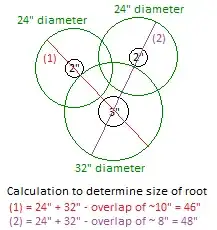According to this excellent page from Iowa State University, you need a 24" root ball for a 2" caliper tree and a 32" root ball for a 3" caliper tree (see that page for a handy chart, and note that it states that the "caliper of the trunk [is] measured 6 inches above the ground up to and including 4 inch size").
In order to best calculate the diameter of the ball you'll need to make, you should measure each tree separately. It's easiest if you make a chart something like this:

As you can see, I measured each tree's suggested diameter separately, combined them to come up with a common width, then subtracted the amount of overlap between the two diameters. In my example, I'd need a 48" root ball, centered between the trees. Assuming your trees are spaced closer together than those in my drawing, you're probably looking at an approximately 40" root ball, although I'd definitely do the exercise as shown in my sample to get a better figure. Of course, as blacksmith noted in their comment, the width of a root ball is often the width of the backhoe's bucket.
Note also that the site I link too strongly recommends only moving trees when they are dormant.
